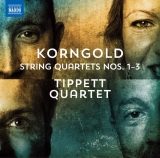Erich Wolfgang Korngold hat seine drei Streichquartette in Jahrzehnten großer Verwerfungen komponiert – von den Nachbeben des Ersten Weltkrieges bis zum Zusammenbruch nach dem Zweiten Weltkrieg. Seine Musik erzählt von dieser Zerrissenheit und auch Ungewissheit.
Das erleben wir gleich mit dem Beginn von Streichquartett Nr. 1, in dem das Tippett Quartet einen sehr griffigen, kantigen Ton anschlägt, der die innere Unwucht perfekt illustriert.
Dennoch holt uns die Interpretation dieser Komposition aus den Jahren 1922/23 nicht so richtig ab. Sie wirkt seltsam monochrom und letztendlich spannungsarmer als jene der Quartette Nr. 2 und 3. Darin setzt das Tippett Quartet seine engagierte und authentische Spielart in einer wesentlich kontrastreicheren Lektüre um – etwa im Larghetto von Quartett Nr. 2, in dem eine geheimnisvolle, durch den schwebenden Klang unheilschwangere Atmosphäre entsteht. Korngold hat im Entstehungsjahr 1933 nach der Machtübernahme der Nazis gespürt, welche Katastrophe über die Menschheit hereinbrechen würde. Das wird noch einmal finalen Walzer-Satz mit den subtilen, bitteren ironischen Untertönen, die uns das Tippett Quartet spüren lässt, unterstrichen.
Insgesamt überzeugen die Musiker durch die packende und schön austarierte Klangdichte, die keine Unschärfen im musikalischen Text zulässt, und höchste Emotionalität schafft.
Erich Wolfgang Korngold composed his three string quartets during decades of great upheaval – from the aftershocks of World War I to the collapse after World War II. His music tells of this brokenness and also uncertainty.
We experience this right from the start of String Quartet No. 1, in which the Tippett Quartet strikes a very gripping, angular note that perfectly illustrates the inner turmoil.
Still, the interpretation of this 1922/23 composition isn’t really gripping. It seems oddly monochromatic and ultimately more lacking in tension than that of Quartets Nos. 2 and 3, in which the Tippett Quartet applies its committed and authentic playing to a much more contrasting reading – for example, in the Larghetto of Quartet No. 2, in which a mysterious atmosphere is created that is ominous because of the floating sound. Korngold sensed in the year of composition, 1933, after the Nazis came to power, what catastrophe would befall humanity. This is emphasized once again in the final waltz movement with the subtle, bitter ironic undertones that the Tippett Quartet makes us feel.
Overall, the musicians are convincing with the gripping and beautifully balanced density of sound, which allows no blurring in the musical text, and creates the highest emotionality.
























